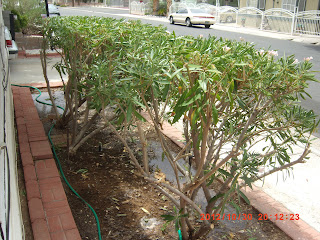 |
| This mulched bed has the start of a rain garden at the toe (or base) of the slope. We'll be planting small cacti and annual flowers into it this fall. This trench slopes towards the middle from both ends rather than towards the street. |
Even though we don't get much rain in Southern Nevada, rarely more than two to three inches a year, we still get a lot of runoff and even some flooding when it does happen. Also, irrigation leaks and activities such as washing your car at home and hand watering can lead to runoff if not done carefully.
It's impractical and downright silly to demand that people stop using water outside and there is nothing we can do to stop cloud-bursts from dumping rain on us (why anyone would want to, I don't know since rainwater is the best irrigation one could hope for). But we can make an effort to keep what water we do have on our properties and out of the storm sewers.
The easiest solution is to reshape the landscape around your property. You still want the soil to slope away from your buildings, but it can then slope towards the middle of a flower bed or lawn rather than towards the street. It can usually be done by hand with shovels and maybe a pickaxe if needed. One can dig a trench or a series of holes around the property. The deeper you dig them, the longer they will last before they need dug out again.
Always be sure to call your utility companies and whoever installed your irrigation system before you dig to make sure you don't wind up digging up a pipe or wiring! Then, slope the soil gently to direct the runoff towards the digging. The bottom of the hole or trench is then lined with crushed rock to help maintain drainage. Some people add geotextile fabric below the rock, but I've found it doesn't really help and just gets in the way when you need to re-dig the hole. You can either fill the whole trench or hole with crushed rock or add layers of coarse sand or fine gravel on top of it.
To make it even better, you can turn this into a rain garden and plant lovely flowers in and around the trench or hole. Be sure to only use annuals or biennials (plants that live only two years). Perennial plants will develop tough root systems that will make it really difficult to re-dig the trench later on.
Others have done such a great job of diagramming and describing rain gardens in detail that I will leave a link below so that you can go to their page rather than trying to make my own. Just be sure to ignore any advice on these pages that suggests planting perennial plants, trees and/or shrubs in or near your rain garden.
Low Impact Rain Garden Design Templates
This article (in .pdf form) from the University of Nevada Reno does a good job of summarizing the many ways one can soak up rain, irrigation and spill water rather than letting it run off. I couldn't really say it much better myself so I'll recommend it to you.
Ways to make water soak into your property
This website is excellent in that it helps explain the difference between two terms that get used interchangeably but mean quite different constructions and that are often confused with rain gardens: french drains and swales. These are both similar to a rain garden only they actually direct runoff away from the property, but at least slow it down first compared to just a smooth pipe running from a grate or a concrete trench. This website is done by an association of certified home inspectors so their information is pretty reliable. May as well make your home and business construction pass inspection by design rather than having to re-do it later after it is inspected.
French drain inspections
Finally, if you are considering installing or repairing the pavement in your driveway or sidewalks, here's a more environmentally friendly option to concrete that will also help keep water on your property rather than letting it run away. It's a vendor neutral article by a non profit organization so it's facts rather than hype.
Permeable Pavement
Not only are these permeable pavers and paving systems good for soaking up water, but they are actually easier to do compared to mixing and pouring concrete. I've done enough laying of concrete to know that I'd rather not do it if I can help it. :)
A rain garden can
enhance the beauty of your property and help manage runoff at the same time.
 |
| Rain gardens can be established with or without a drain to the sewage system. They are great to install around existing drainage systems to slow and sometimes even intercept the water before it gets to the drain. |



